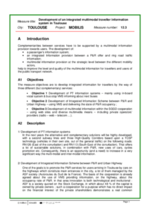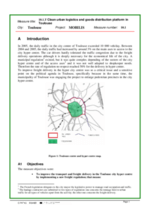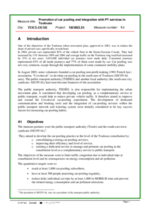About the project
These partners worked together to create a new culture for clean urban mobility in the wider context of sustainable development, ensuring the involvement of all stakeholders and the participation of the public.
The project comprised a total of 46 measures that addressed all CIVITAS policy fields, integrated into a detailed work programme over a duration of four years (2005 to 2009).
MOBILIS aimed to demonstrate the added value of developing and implementing broad integrated packages of policies and measures. The exchange of experiences and good practice between the partners therefore played a crucial role. Specific coordination activities focused on the promotion and integration of five policy themes across all sites and measures:
- social inclusion and equity in mobility;
- transition strategies towards alternative fuel production and use;
- planning and organising mobility at agglomeration level;
- understanding and changing mobility behaviour; and
- the costs and benefits of using new technologies in transport.
The common objectives of the MOBILIS mobility measures in the five cooperating cities were to:
- foster a transition process towards the broad use of alternative fuels and clean, energy-efficient vehicles;
- promote a modal shift away from the private car towards sustainable transport modes;
- improve the quality and fair share of public spaces;
- create transport-minimising urban structures;
- foster safety, security, social inclusion and equity in urban mobility;
- reduce noise and improve air quality in urban areas;
- support economic development and competitiveness;
- advance efficient planning, management and implementation processes and coordination between mobility stakeholders at different administrative levels;
- increase the participation of citizens and civil society in environment- and mobility-related decision making;
- raise awareness of sustainable mobility issues and promote behavioural change; and
- improve the innovative and creative capacities of local mobility stakeholders.
Implementing sustainable mobility
The key selected mobility measures during CIVITAS MOBILIS included:
- demonstrating the large-scale application of alternative fuels;
- widening experiences with navigation systems such as EGNOS/GALILEO and implementing intelligent transport system (ITS) applications to improve traffic conditions and public transport services;
- managing the accessibility of sensitive areas through innovative zoning approaches;
- demonstrating two new approaches to clean urban logistics and implementing one new freight distribution centre operating with clean vehicles;
- ensuring social inclusion by enhancing the accessibility of mobility services (physical, psychological, economic and information related);
- enhancing public transport quality and its integration with other transport modes (private car, bicycle) through innovative planning and service development;
- providing new targeted mobility services that change the dominant concepts of vehicle ownership and use (car pooling and car sharing, mobility card schemes);
- promoting sustainable mobility, modal shift (towards walking, cycling, public transport) and behavioural change through targeted and personal marketing, service development, information dissemination, education and training; and
- contributing to the Europe-wide evaluation and dissemination of the results for promotion via the CIVITAS Initiative.
Project results
The implementation of the 49 measures resulted in the following key achievements:
- Alternative fuels and clean, energy-efficient vehicles were put into operation and partners improved their knowledge of the related benefits and constraints. Further development, resulting in increased impact, continued after the end of the project.
- The new approach towards car ownership and car use, the promotion of public transport and cycling, and the improvement of sustainable mobility services encouraged a modal shift towards public transport, cycling and walking.
- Access restrictions improved the quality and fair share of public spaces.
- New infrastructure and equipment were installed for pedestrians, cyclists and public transport. Accessibility for disabled people was improved to foster safety, security and social inclusion, improving equity in urban mobility.
- Private car access to the city centre was restricted in a number of MOBILITY cities. Environmental zones were created, and environment-friendly transport modes were introduced. New waterbuses, for example, helped to reduce noise levels and improve air quality in some urban areas.
- New parking and freight delivery policies were implemented, limiting city centre access exclusively to local users.
- New commuter mobility plans were created to support economic development and competitiveness.
- The identification of relevant interest groups and the creation of participative working groups contributed to efficient planning, management and implementation. Coordination among various stakeholders at different administrative levels had a beneficial impact on the development of various mobility services.
- Individual citizens and citizens associations were brought into the working groups, contributing to improved public participation in mobility-related decision making.
- Marketing and information campaigns raised awareness of sustainable mobility and promoted behavioural change.
- The development of telematic and intermodal systems improved the innovative and creative capacities of local mobility stakeholders.
Cities
Fast Facts
January 2005 - January 2009
Project duration
32 partners
Project partners
€21,758,451
Project funding
47 measures
Measures implemented
Latest
Knowledge Bank
Mobility solutions
Thematic areas
Active mobility
Collective passenger transport & shared mobility
- Car sharing
- Bike sharing
- Intermodality
- Ticketing and tariffs
Clean & energy-efficient vehicles
- Cleaner fleets
Smart, Sustainable, Connected and Shared mobility
Demand & urban space management
- Access restrictions and management
Road safety & security
Urban logistics
Integrated & inclusive planning
- Multimodal hubs
- Cooperation of policy fields and institutional stakeholders
- Sustainable Urban Mobility Plans - SUMP


















